Lessico
Parias
Trimeresuro Trimeresurus
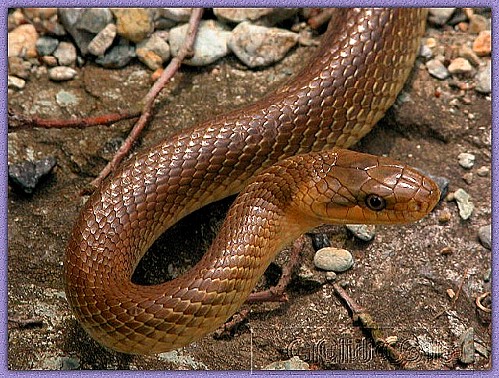
Il colubro
di Esculapio - Elaphe longissima
nella versione cromatica conosciuta dagli antichi
ai quali era noto come pareías in greco e come parias in latino
Il sostantivo greco maschile pareías identificava un serpente di colore rosso scuro sacro ad Esculapio (Cratino 241, Aristofane Plutus 690, Demostene Circa la corona 260) ed era un termine derivato da pareiá = guancia, gota. Secondo i lessicografi antichi veniva detto pareías in quanto caratterizzato da guance cascanti.
Ma l'attuale Colubro di
Esculapio![]() , Elaphe
longissima, non ha guance cascanti, né vengono descritte come tali da
Giglio Gregorio Giraldi
, Elaphe
longissima, non ha guance cascanti, né vengono descritte come tali da
Giglio Gregorio Giraldi![]() che trae la notizia da
Eliano
che trae la notizia da
Eliano![]() : "Apud Aelianum hoc etiam notavi, Parian serpentem, quam Apollodorus paruan
vocabat, igneo esse colore, et acerrimo oculorum visu, ore largo: ex quo fit,
ut nihil mordendo noceat. Quin etiam mitis esse dicitur, et propterea (inquit)
deorum humanissimo Aesculapio ipsum consecrarunt, eiusque ministerio
dedicarunt. (Historiae
Deorum Gentilium Syntagma
VII - De Apolline, Aesculapio, Musis,
Aurora - Basileae, Oporinus 1548)
: "Apud Aelianum hoc etiam notavi, Parian serpentem, quam Apollodorus paruan
vocabat, igneo esse colore, et acerrimo oculorum visu, ore largo: ex quo fit,
ut nihil mordendo noceat. Quin etiam mitis esse dicitur, et propterea (inquit)
deorum humanissimo Aesculapio ipsum consecrarunt, eiusque ministerio
dedicarunt. (Historiae
Deorum Gentilium Syntagma
VII - De Apolline, Aesculapio, Musis,
Aurora - Basileae, Oporinus 1548)
Se non bastasse, l'Elaphe
longissima non solo
non ha guance cascanti, ma neppure un colore rosso fuoco (come riporta Giraldi
per il parias di Eliano) bensì giallo-marrone
sul dorso e un ventre giallo chiaro. A dire il vero la colorazione di questo
serpente è alquanto camaleontica, come possiamo vedere dalla collezione di
immagini raccolte nel web![]() .
.
Pareías era anche un soprannome di Atena di cui ci parla
Pausania![]() in Laconia III,20,8 dove specifica che sulla strada che
conduceva da Sparta all'Arcadia c'era un'immagine di Atena che era così
denominata. Chi ce lo riferisce è George Roy (www.goddess-athena.org) il
quale specifica che questo serpente sacro a Esculapio aveva un colore marrone
rossastro: Pareias was a reddish-brown snake, sacred to Asclepius.
in Laconia III,20,8 dove specifica che sulla strada che
conduceva da Sparta all'Arcadia c'era un'immagine di Atena che era così
denominata. Chi ce lo riferisce è George Roy (www.goddess-athena.org) il
quale specifica che questo serpente sacro a Esculapio aveva un colore marrone
rossastro: Pareias was a reddish-brown snake, sacred to Asclepius.
Isidoro di Siviglia![]() lo descrive così citando anche Lucano
lo descrive così citando anche Lucano![]() (Bellum
civile o Pharsalia): Parias serpens quae semper in cauda ambulat et
sulcum facere videtur. De quo idem Lucanus (9, 721): Quo contentus iter cauda
sulcare parias. (Etymologiae XII,4,27)
(Bellum
civile o Pharsalia): Parias serpens quae semper in cauda ambulat et
sulcum facere videtur. De quo idem Lucanus (9, 721): Quo contentus iter cauda
sulcare parias. (Etymologiae XII,4,27)
In zoologia il genere Parias è stato recentemente riproposto, staccando così alcune specie di serpenti della famiglia Crotalidi dal genere Trimeresurus. Il serpente di Esculapio non ha nulla a che fare con il moderno genere Parias, in quanto questo genere di Crotalidi appartiene solo al continente asiatico.
Come serpente di Esculapio viene identificato non un Crotalide, ma un
Colubride, e precisamente il Colubro di
Esculapio, Elaphe longissima, presente tanto in Europa che in Asia
occidentale. Il termine Parias
citato da Aldrovandi a pagina 306![]() della sezione relativa al pollo è tratto
da Fulvio Orsini
della sezione relativa al pollo è tratto
da Fulvio Orsini![]() . Sta di fatto che Parias fu utilizzato da Gray nel
1849 per identificare dei Crotalidi, come vedremo appresso.
. Sta di fatto che Parias fu utilizzato da Gray nel
1849 per identificare dei Crotalidi, come vedremo appresso.
Trimeresuro
Trimeresurus: dal greco trimerës, di tre parti+ourá,
coda. Genere di serpenti Crotalidi del continente asiatico che conducono
un'esistenza arboricola, come sta a indicare la prensilità della loro coda.
Di dimensioni modeste, il loro veleno ha potenza che varia da specie a specie
e sono pericolosi per l'uomo. Il trimeresuro verde e giallo (Trimeresurus
flavoviridis![]() ), esclusivo delle Ryukyu (arcipelago giapponese dell'Oceano
Pacifico che si allunga ad arco per ca. 1200 km dall'isola di Kyushu fino
all'isola di Taiwan), lungo fino a 1,50 m, è il più pericoloso
rappresentante del suo genere (può causare anche la morte). Il trimeresuro
del bambù (Trimeresurus gramineus
), esclusivo delle Ryukyu (arcipelago giapponese dell'Oceano
Pacifico che si allunga ad arco per ca. 1200 km dall'isola di Kyushu fino
all'isola di Taiwan), lungo fino a 1,50 m, è il più pericoloso
rappresentante del suo genere (può causare anche la morte). Il trimeresuro
del bambù (Trimeresurus gramineus![]() ), lungo meno di 1 m, presenta una
colorazione prevalentemente verde; vive nelle macchie di bambù dell'Asia
sud-orientale. Il Trimeresurus sumatranus
), lungo meno di 1 m, presenta una
colorazione prevalentemente verde; vive nelle macchie di bambù dell'Asia
sud-orientale. Il Trimeresurus sumatranus![]() o Parias sumatranus,
come recita questo stralcio di didascalia presente nel web, è assai
pericoloso:
o Parias sumatranus,
come recita questo stralcio di didascalia presente nel web, è assai
pericoloso:
“Trimeresurus or Parias sumatranus is a large and powerful snake, capable of inflicting rather grevious injury. This individual was very, very large, as far as Southeast Asian pitvipers go, measuring about an arm and a half in length (this non-scientific medievalish metric is also known as the "Measurement of a pitviper from a safe distance" metric). (http://frogweb.org)
Ultimamente è stata proposta una nuova classificazione del genere Trimeresurus, riesumando il genere Parias di Gray (1849):
“Malhotra & Thorpe (2004) used phylogenetic analysis of four mitochondrial genes to analyse the phylogeny of the Asian pitvipers. Their analyses, supported by additional evidence from hemipenial morphology and aspects of scalation, defined a number of well-defined species groups, particularly within Trimeresurus sensu lato. On this basis, the genus Trimeresurus was split into ?? genera. The genus Trimeresurus now contains solely the species from the Indian subcontinent as well as the T. puniceus group. Malhotra & Thorpe resurrected the genus Parias Gray, 1849 for the Indomalayan sumatranus-hageni group, Cryptelytrops Cope, 1860 for the albolabris group, Peltopelor Gunther, 1864 for the species macrolepis, and describe the new genera Viridovipera for the stejnegeri group, Popeiapopeiorum complex, and Himalayophis for the species tibetanus. The Table below shows the allocation of the species previously included in Trimeresurus Ovophis chaseni was found to be unrelated to other Ovophis, and Malhotra and Thorpe named the new genus Garthius to accommodate this species. Trimeresurus gracilis was shown to be the sister group of what is currently referred to as Ovophis okinavensis, but these two are not closely related to O. monticola. The nomenclature of these taxa requires further clarification. - Table 1. Classification of the species previously assigned to Trimeresurus according to Malhotra & Thorpe (2004). Trimeresurus gracilis remains unassigned. [...] Parias: flavomaculatus - hageni - malcolmi - mcgregori - schultzei - sumatranus - (http://biology.bangor.ac.uk)
Common names: Asian pit vipers, Asian lanceheads, Asian lance-headed vipers. Trimeresurus is a genus of venomous pitvipers found in Asia from Pakistan, through India, China, throughout Southeast Asia and the Pacific Islands. Currently 35 species are recognized.
Most are relatively small, primarily arboreal species, with thin bodies and prehensile tails. They are typically green in color, but some species also have yellow, black, orange or red markings. Their diet includes a variety of other animals, including rodents, lizards, amphibians and birds.
Like most viper species, they are ovoviviparous. Their venom varies between species in toxicity, but all are primarily hemotoxic and considered to be medically significant to humans.
Geographic range: Southeast Asia from India to southern China and Japan, and the Malay Archipelago to Timor.
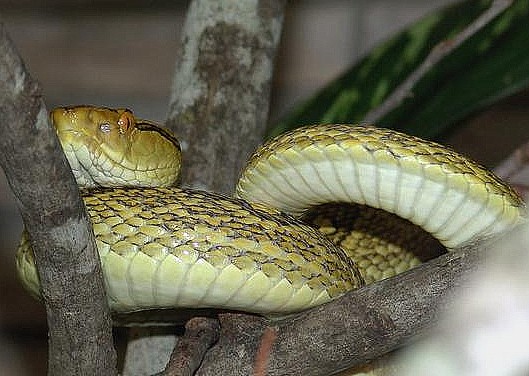
Common names: habu, Okinawa habu, Okinawan habu, Kume Shima habu. Trimeresurus flavoviridis is a venomous pitviper species found in Japan in the Ryukyu Islands. No subspecies are currently recognized.
T. flavoviridis grows to an average length of 4-5 feet (122-152 cm). With a maximum of 7.5 feet (229 cm), it is the largest member of its genus. Slenderly built and gracefully proportioned with a large head. The tail, however, is not prehensile. Scalation includes 35 (sometimes 31, 33, 37 or 39) rows of dorsal scales at midbody, 217-239 ventral scales, 72-95 subcaudal scales and 7-10 supralabial scales. The crown is covered with small scales.
The color pattern consists of a light olive of brown ground color overlaid with elongated dark green or brownish botches. The blotched have yellow edges, sometimes contain yellow spots, and frequently fuse to produce wavy stripes. The belly is whitish with dark coloring along the edges.
Geographic range: found in Japan in the Ryukyu Islands, including Okinawa and the Amami Islands. The type locality given is "Amakarima Island (one of the Loo-Choo group)" (= Keramashima, Ryukyu Islands). Common on the larger volcanic islands, but not present on the smaller coral islands.
Habitat: often reported in the transition zone between palm forest and cultivated fields. Found on rock walls and in old tombs and caves.
Behavior: terrestrial and mostly nocturnal, it often enters homes and other structures in search of rats and mice. Bold and irritable, it can strike quickly and has a long reach.
Reproduction: oviparous, it is one of the few pitvipers that lays eggs. Mating takes place in early spring and up to 18 eggs are laid in mid-summer. The hatchlings, which emerge after an incubation period of 5-6 weeks, are 10 inches (25 cm) in length and look the same as the adults.
Predators: to reduce the population on the island of Okinawa, the small Indian mongoose, Herpestes javanicus, was introduced in 1910. Although the effects of this introduction have not been studied, in other such cases the negative effects on species of native birds, mammals, and herpetofauna have been a source of concern for wildlife managers.
Venom: the incidence of snakebite in the Amami Islands is 2 per 1,000 people, which is very high. Fortunately, the venom of this species is of a relatively low toxicity with a fatality rate of only 3%. However, 6-8% do suffer permanent disability. Brown (1973) gives LD50 values of 3.1, 4.3, 3.7, 2.7, 3.7, 3.8 mg/kg IV, 5.1 mg/kg IP and 6.0, 3.5-5.0, 4.5 mg/kg SC for toxicity.
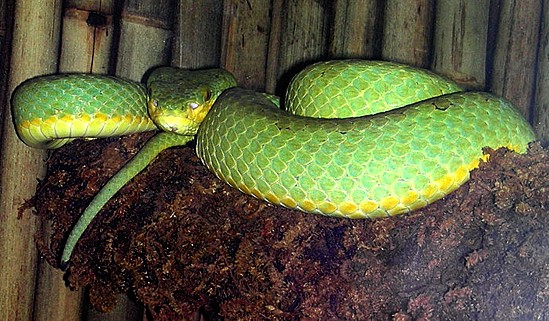
Common names: bamboo pit viper, Indian tree viper, bamboo snake, Indian green tree viper, green tree viper, bamboo viper. Trimeresurus gramineus is a venomous pitviper species found only in southern India. No subspecies are currently recognized.
T. gramineus, Katraj Snake Park, Pune.Rostral scale as deep as broad or broader than deep; upper head-scales small, smooth, imbricate; supraocular scale narrow, rarely broken up; internasals in contact or separated by one or two scales; 8 to 13 scales on a line between the supraoculars; usually one or two, rarely three, series of scales between the suboculars and the labials ; 9 to 12 upper labials, second usually forming the anterior border of the loreal pit, third largest; temporal scales smooth. Scales more or less distinctly keeled, in 21 (rarely 19 or 23) rows. Ventrals 145-175; anal scale entire; subcaudals 53-76. Upper parts usually bright green, rarely yellowish, greyish, or purplish brown, with or without black, brown, or reddish spots ; usually a light, white, yellow, or red streak along the outer row of scales ; end of tail frequently yellow or red; lower parts green, yellow, or whitish. Grows to a length of 2.5 feet (0.76 m); tail 6-5 inches.
Geographic range: the range of this species has been restricted to southern India. According to Russell (1796), the type locality is "Vizagapatam, India."
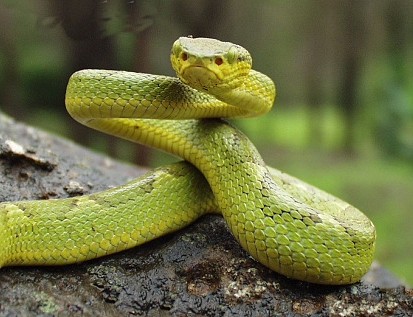
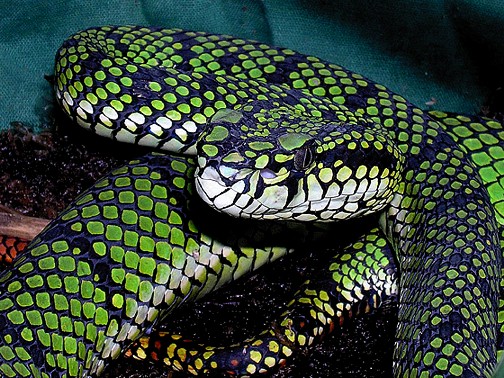
Common names: Sumatran pitviper, Sumatran tree viper, Sumatran pit viper. Trimeresurus sumatranus is a venomous pitviper species found in Thailand, Malaysia and Indonesia. Arboreal, its coloration is pale green with a red tail. Two subspecies are currently recognized, including the nominate subspecies described here.
An arboreal species that is pale green in color with a red tail. Scalation includes 21 (23) rows of dorsal scales at midbody, 183-190/182-191 ventral scales in males/females, 57-66/55-64 subcaudal scales in males/females and 8-10 supralabial scales. The diet consists mainly of small mammals and birds.
Geographic range: found in southern Thailand, West and East Malaysia (Sabah and Sarawak on Borneo) and Indonesia (Bangka, Billiton, Borneo, Sumatra and the nearby islands of Simalur, Nias, and possibly the Mentawai Islands [Sipora]). The type locality given is "Sumatra."
According to Gumprecht et al. (2004), the records regarding its occurrence in the Mentawai Islands are probably based on T. hageni.